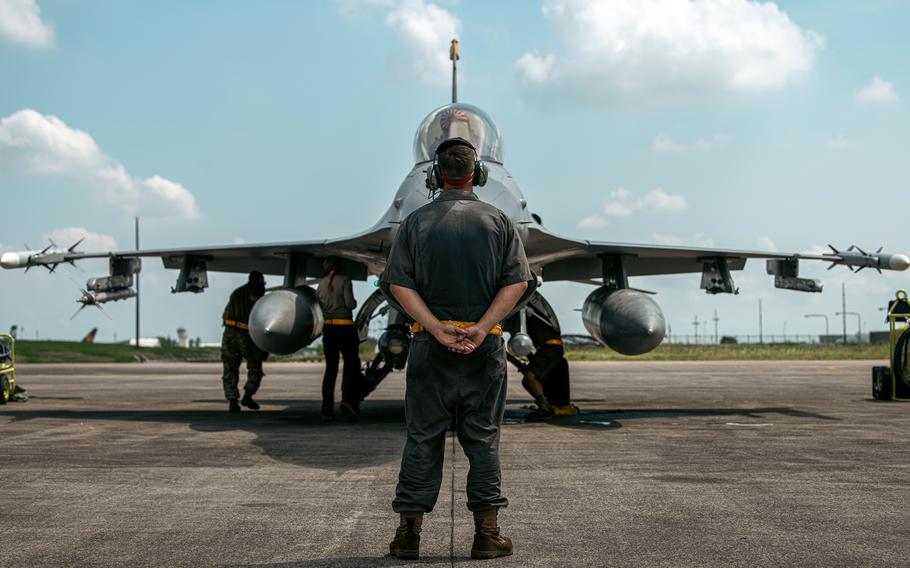
Airman 1st Class Cole Muder prepares to marshal an F-16 Fighting Falcon during exercise Cope Thunder at Clark Air Base, Philippines, May 11, 2023. (Sebastian Romawac/U.S. Air Force)
The Philippines plans to purchase a squadron’s worth of advanced U.S. fighter jets to shore up its air force, according to a recent Department of Defense notification of a proposed sale.
The $5.58 billion package includes 20 Block 70/72 F-16 Fighting Falcons — 16 C models and four D models — along with spare parts, weapons and support systems, the Defense Security Cooperation Agency said in a news release April 1.
Lockheed Martin, the aircraft’s manufacturer, describes the Block 70/72 as the most advanced fourth-generation fighter ever built. While the model features upgraded avionics, tracking and targeting systems, it lacks the stealth capabilities of fifth-generation fighters such as the F-22 Raptor and F-35 Lightning II.
“If this report is accurate, and the Philippines is getting Block 70/72 F-16s, that is a major improvement in capability,” Dan Leaf, the former deputy commander of what is now called Indo-Pacific Command, said by email Monday.
“These new jets have a very complete set of advanced capabilities that should give [China] pause. It is also a major investment, and if the purchase goes through will be a strong statement of Philippine commitment to its alliance with the United States.”
The State Department approved the proposal, which now requires congressional notification. Although Congress does not directly approve foreign military sales, it may block them.
The deal includes spare engines, radars, mission computers, navigation systems, and other related equipment. The package also provides for a range of munitions and support gear, including:
• 40 AIM-9X Block II Sidewinder air-to-air missiles
• 112 AIM-120C-8 Advanced Medium Range Air-to-Air Missiles, also known as AMRAAMs
• 60 MK-82 500-pound general-purpose bombs
• 60 MK-84 2,000-pound general-purpose bombs
“This proposed sale will support the foreign policy and national security of the United States by helping to improve the security of a strategic partner that continues to be an important force for political stability, peace, and economic progress in Southeast Asia,” the agency said.
The Philippines is the United States’ oldest military ally in the Indo-Pacific and is considered a strategic counterbalance to Beijing’s growing influence in the South China Sea. The Philippine and Chinese coast guards have clashed repeatedly over the past year amid overlapping maritime claims, including an area within the Philippines’ exclusive economic zone.
Each side has accused the other of intentionally ramming patrol vessels. In one June 17 incident, Chinese coast guard crews wielding axes, knives and rocks injured a Philippine crew member, according to news reports.